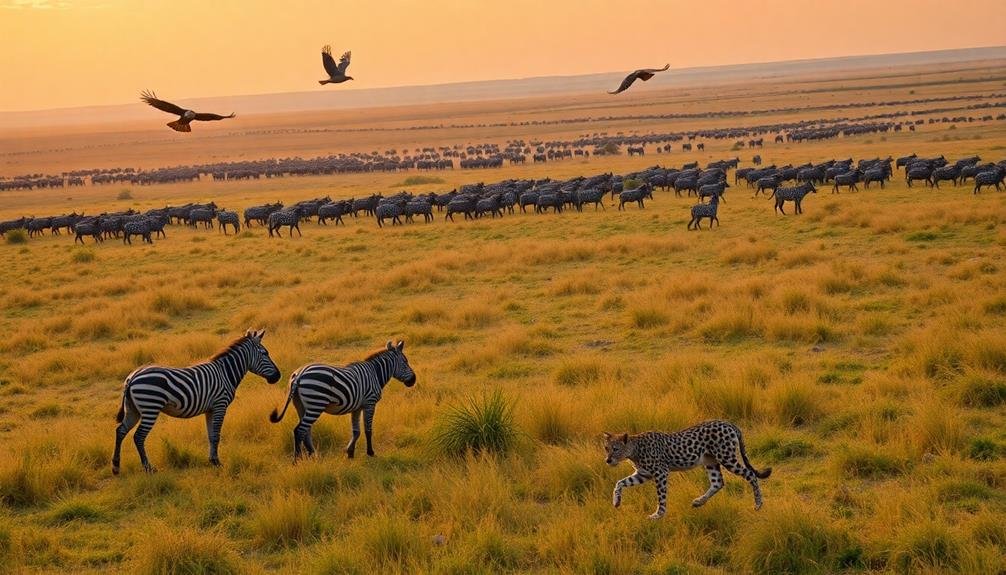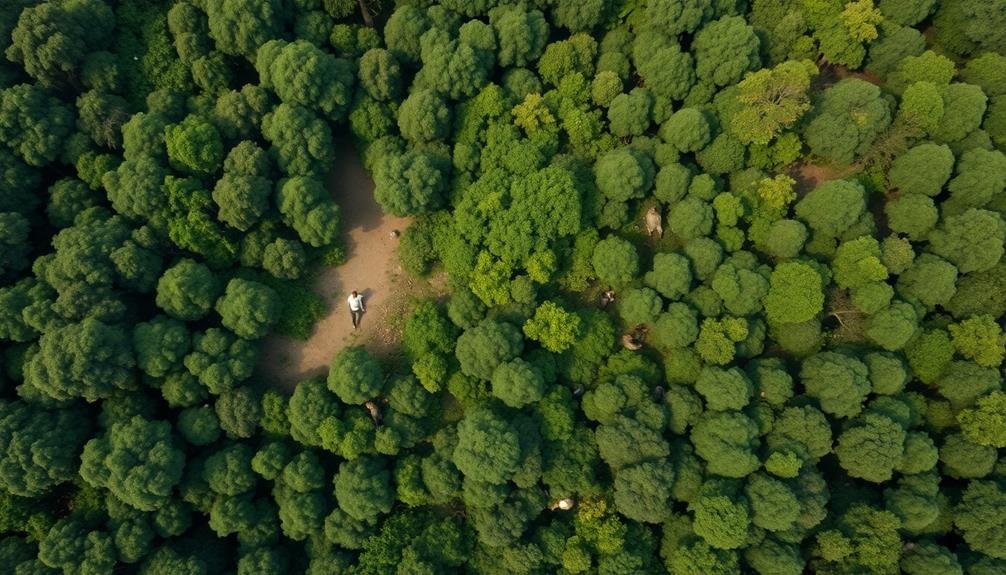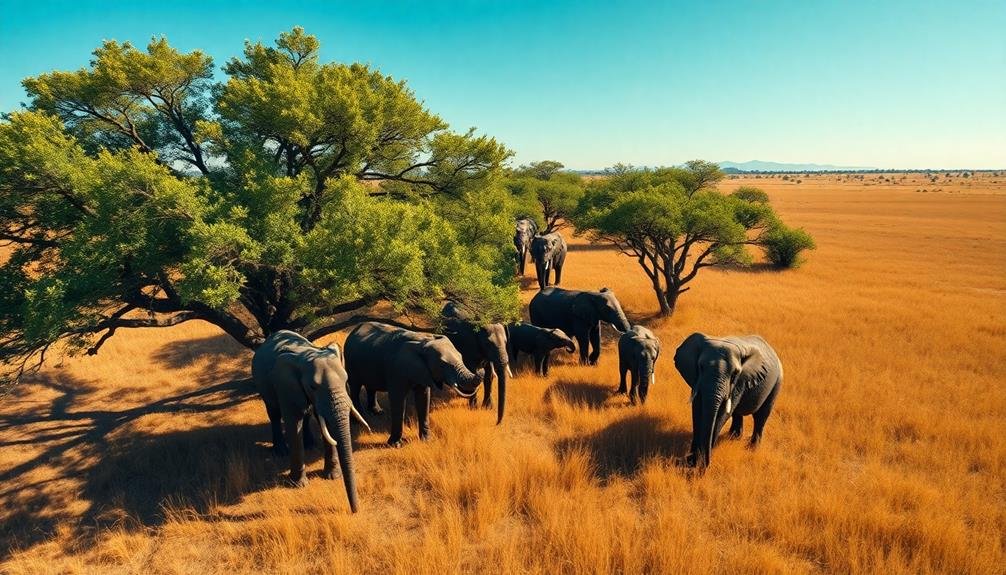You'll be amazed by these groundbreaking wildlife insights from aerial studies. Elephant migration patterns span thousands of kilometers, guided by mental maps. Hidden predator-prey dynamics reveal complex ecosystem interactions. Advanced mapping techniques uncover rare species habitats. Primate social structures show intricate hierarchies. Seabird nesting behaviors adapt to unique environments. Nocturnal animal activities are tracked using thermal imaging. Big cat territories are mapped with precision. Migratory bird formations demonstrate energy-saving V-shapes. Polar bear hunting strategies are analyzed in detail. These discoveries offer a bird's-eye view of nature's secrets, with more surprises waiting to be uncovered.
Elephant Migration Patterns Revealed

Through extensive tracking and data analysis, scientists have uncovered fascinating insights into elephant migration patterns. You'll be amazed to learn that these massive creatures travel up to 3,000 kilometers annually in search of food and water. Their journeys aren't random; elephants follow well-established routes passed down through generations.
Researchers have discovered that elephants use mental maps to navigate, remembering key locations like water sources and fertile feeding grounds. They've also found that these animals can sense rainfall from over 150 miles away, adjusting their routes accordingly.
Climate change is impacting elephant migration, forcing herds to travel longer distances and explore new areas. This adaptation has led to increased human-elephant conflicts as the animals venture into populated regions.
You might be surprised to know that elephants don't migrate alone. They travel in family groups led by experienced matriarchs, whose knowledge is essential for the herd's survival. These leaders guide younger elephants, teaching them important navigation skills and survival techniques.
Understanding these migration patterns is significant for conservation efforts, helping protect essential corridors and habitats that elephants depend on during their epic journeys.
Hidden Predator-Prey Dynamics Uncovered

While elephant migrations showcase large-scale animal movements, recent studies have revealed intricate predator-prey dynamics occurring on a smaller scale. You'll find these hidden interactions are essential for maintaining ecosystem balance.
Researchers have uncovered fascinating patterns in predator-prey relationships:
| Predator | Prey | Hunting Strategy | Prey Defense |
|---|---|---|---|
| Wolf | Elk | Pack coordination | Herd vigilance |
| Lion | Zebra | Ambush tactics | Striped camouflage |
| Cheetah | Gazelle | High-speed chase | Zigzag running |
| Orca | Seal | Coordinated attacks | Ice floe refuge |
You'll notice how each predator has adapted specific hunting techniques, while prey species have evolved unique defense mechanisms. These intricate dynamics shape animal behavior and population dynamics.
Rare Species Habitat Mapping

As conservationists endeavor to protect endangered species, rare species habitat mapping has become an essential tool.
You'll find that this advanced technique combines aerial imagery, GPS data, and on-the-ground observations to create detailed maps of where rare animals live and thrive. These maps aren't just pretty pictures; they're vital for understanding species distribution, identifying important habitats, and planning conservation efforts.
When you're involved in rare species habitat mapping, you'll typically follow these steps:
- Collect data from various sources, including satellite imagery, drone footage, and field surveys
- Analyze the data using Geographic Information Systems (GIS) and machine learning algorithms
- Create thorough maps that highlight key habitat features and potential threats
You'll discover that these maps reveal patterns and connections that weren't visible before.
They'll help you identify corridors between fragmented habitats, locate undiscovered populations, and predict how climate change might affect species' ranges.
Social Structures in Primate Groups

You'll discover intricate social dynamics when observing primate groups.
From aerial vantage points, you can map out dominance hierarchies, revealing who's in charge and how power shifts occur.
As you watch closely, you'll uncover complex grooming patterns that strengthen social bonds, while also witnessing fascinating mating rituals that shape group dynamics.
Dominance Hierarchies From Above
Observing primate groups from a bird's-eye view reveals fascinating insights into their social structures. You'll notice intricate dominance hierarchies that shape the group's dynamics. These hierarchies aren't always linear, but often complex networks of relationships.
From above, you can spot key indicators of dominance:
- Spatial arrangements: Dominant individuals often occupy central positions within the group, while subordinates remain on the periphery.
- Grooming patterns: Higher-ranking primates receive more grooming attention from others, reinforcing their status.
- Access to resources: Dominant members have priority access to food, water, and desirable resting spots.
You'll see how these hierarchies influence daily life. Dominant individuals initiate group movements, mediate conflicts, and have preferential mating opportunities.
They're also more likely to lead during potential threats or when exploring new territories.
It's important to note that dominance isn't always about aggression. Alliances, coalitions, and social skills play essential roles in maintaining or challenging the hierarchy.
Grooming Patterns Revealed
When primates engage in grooming, they reveal intricate social dynamics within their groups. You'll notice that grooming isn't just about hygiene; it's a complex social currency. Higher-ranking individuals often receive more grooming than they give, reinforcing their status.
You'll see that grooming sessions can last for extended periods, sometimes up to an hour, indicating the importance of these interactions.
From above, you can observe patterns in grooming networks. You'll find that closely related individuals tend to groom each other more frequently.
However, unrelated individuals also participate in grooming exchanges, often to forge alliances or gain favor. You'll notice that during times of tension, grooming increases, serving as a way to reconcile conflicts and reduce stress within the group.
Mating Rituals Observed
In accordance with the social hierarchy, primate mating rituals display a complex interplay of dominance, competition, and strategy. You'll observe that higher-ranking males typically have greater access to females, but this doesn't guarantee reproductive success.
Females often play an active role in mate selection, employing various tactics to choose the best genetic match for their offspring.
As you study these rituals, you'll notice three key aspects:
- Courtship displays: Males perform elaborate behaviors to attract females, including vocalizations, physical displays, and grooming.
- Coalition formation: Lower-ranking males may form alliances to challenge dominant individuals and gain mating opportunities.
- Mate guarding: After successful copulation, males often stay close to females to prevent other males from mating with them.
You'll find that these mating rituals aren't just about reproduction; they're integral to maintaining social order within the group. They reinforce hierarchies, strengthen bonds, and contribute to the overall stability of the primate society.
Nesting Behaviors of Seabirds

Seabirds' nesting behaviors often come down to a delicate balance between safety and accessibility. You'll find these clever birds choosing nesting sites that protect their eggs and chicks from predators while still allowing easy access to food sources. Coastal cliffs, remote islands, and even man-made structures serve as prime real estate for seabird colonies.
Different species exhibit unique nesting strategies. Some, like puffins, dig burrows in soft soil, while others, such as gannets, construct elaborate nests from seaweed and mud. You'll notice that many seabirds return to the same nesting sites year after year, forming large colonies that provide additional protection through strength in numbers.
| Species | Nest Type | Preferred Location |
|---|---|---|
| Puffin | Burrow | Grassy clifftops |
| Gannet | Platform | Rocky outcrops |
| Tern | Scrape | Sandy beaches |
When observing seabird nesting behaviors, you'll see intricate courtship rituals, careful nest maintenance, and dedicated parental care. These behaviors guarantee the survival of their offspring in harsh coastal environments, showcasing the remarkable adaptations of seabirds to their unique ecological niche.
Whale Communication Patterns Observed

Four primary types of whale communication patterns have been observed by researchers. These patterns include vocalizations, body language, breaching, and echolocation. You'll find that each type serves a specific purpose in the whales' social and survival behaviors.
Vocalizations are perhaps the most well-known form of whale communication. They range from the haunting songs of humpback whales to the clicks and whistles of orcas. These sounds can travel for miles underwater, allowing whales to communicate over vast distances.
Body language is another important aspect of whale communication. You'll notice whales use various movements to convey messages, such as:
- Tail slapping to express aggression or warning
- Spy-hopping to observe their surroundings
- Fluke-up diving to signal the start of an extensive exploration
Breaching, where whales launch themselves out of the water, serves multiple purposes. It's believed to be a form of communication, as well as a way to remove parasites and possibly even for play.
Lastly, echolocation is used primarily by toothed whales for navigation and hunting. They emit high-frequency sounds and interpret the echoes to locate objects and prey in their environment.
Nocturnal Animal Activity Tracked

You'll find that thermal imaging has revolutionized our understanding of nocturnal animal behavior, revealing intricate activity patterns previously hidden from view.
By mapping predator-prey interactions at night, researchers have uncovered complex ecological relationships that shape ecosystems.
Surprisingly, you'll discover that light pollution has unexpected effects on nocturnal creatures, altering their natural rhythms and behaviors in ways we're only beginning to comprehend.
Thermal Imaging Reveals Patterns
Researchers have made significant strides in understanding nocturnal animal behavior thanks to thermal imaging technology. You'll find that this non-invasive method allows scientists to observe animals in their natural habitats without disturbing them. By detecting heat signatures, thermal cameras can track movements and patterns that were previously hidden in the darkness.
With thermal imaging, you're able to witness a whole new world of wildlife activity. Here are three key insights this technology has revealed:
- Hunting patterns of predators, showing how they stalk and pursue prey
- Social behaviors and group dynamics among nocturnal species
- Thermoregulation strategies employed by different animals in various environments
You'll be fascinated to learn that thermal imaging has uncovered unexpected behaviors, such as nocturnal pollination by bats and moths.
It's also helped identify previously unknown species and their habitats. By combining this technology with other tracking methods, researchers can now create a more detailed picture of ecosystem dynamics.
This valuable data is essential for conservation efforts and wildlife management strategies, allowing you to better understand and protect the diverse creatures that thrive under the cover of darkness.
Mapping Predator-Prey Interactions
Revealing the hidden dramas of the night, scientists have made significant breakthroughs in mapping predator-prey interactions using advanced tracking technologies. You'll be amazed at how these tools are shedding light on nocturnal animal activities that were once invisible to researchers.
Using GPS collars, motion-activated cameras, and satellite imaging, scientists can now track multiple species simultaneously across vast areas. This data allows them to create detailed maps of animal movements and interactions, revealing fascinating patterns of predator and prey behavior.
| Predator | Prey | Hunting Strategy | Success Rate |
|---|---|---|---|
| Wolf | Elk | Pack pursuit | 14% |
| Mountain Lion | Deer | Ambush | 20% |
| Owl | Mouse | Silent flight | 85% |
| Fox | Rabbit | Stalking | 25% |
You'll find that these maps show how predators adjust their hunting patterns based on prey density and landscape features. They've also uncovered surprising cooperative behaviors among some prey species to avoid predation. By analyzing this data, you can gain insights into ecosystem health, population dynamics, and the impact of human activities on wildlife interactions.
Light Pollution's Unexpected Effects
While mapping predator-prey interactions has provided valuable insights, scientists have uncovered another significant factor affecting nocturnal animal behavior: light pollution.
You'll be surprised to learn how artificial lighting impacts wildlife far beyond what we initially thought. Researchers using satellite imagery and GPS tracking have revealed startling changes in nocturnal animal activity patterns due to light pollution.
Here are three key findings that'll change your perspective on nighttime illumination:
- Predator advantage: Artificial light gives nocturnal predators an edge, extending their hunting hours and increasing their success rates.
- Prey vulnerability: Light-sensitive prey species become more exposed, altering their foraging patterns and reducing their survival rates.
- Breeding disruptions: Light pollution interferes with mating rituals and breeding cycles of various species, potentially impacting population dynamics.
These discoveries have prompted scientists to advocate for "dark sky" initiatives in urban planning.
By reducing unnecessary lighting and using wildlife-friendly illumination techniques, we can mitigate the negative impacts on nocturnal ecosystems.
As you consider your own outdoor lighting choices, remember that even small changes can make a big difference in preserving natural nighttime behaviors.
Territorial Behaviors Among Big Cats

Big cats' territorial behaviors are complex and fascinating aspects of their social structure. You'll find that these behaviors vary among species, but they all serve essential purposes for survival and reproduction.
Lions, for instance, are unique among big cats as they're the only truly social species. They live in prides and defend their territories collectively. You'll often see male lions patrolling and marking their boundaries with urine and roars, while females do most of the hunting within these areas.
In contrast, tigers are solitary and maintain vast individual territories. They'll use scent marking, scratch marks on trees, and vocalizations to communicate their presence to other tigers. You'll notice that male tigers typically have larger territories that may overlap with several females' ranges.
Leopards and jaguars also maintain solitary territories, but they're more adaptable in their habitat choices. You'll find them using scent marking and scratching to define their areas, often in regions where their territories might overlap with other big cats.
Understanding these territorial behaviors is vital for conservation efforts and managing human-wildlife conflicts in areas where big cats still roam.
Migratory Bird Flock Formations

You'll notice migratory birds often fly in V-formations, which provides significant aerodynamic advantages.
This formation allows birds to conserve energy by riding the updraft created by the bird in front, reducing the effort required for long-distance flights.
As the lead position is the most demanding, birds will rotate leadership roles throughout the journey, ensuring the flock's endurance over vast distances.
V-Formation Aerodynamic Benefits
When migratory birds take to the skies in their iconic V-formations, they're not just creating a visually striking pattern. These formations serve an essential aerodynamic purpose, helping birds conserve energy during long-distance flights.
You'll find that the lead bird expends the most energy, breaking through the air resistance, while those following benefit from the updraft created by the bird in front of them. This energy-saving strategy allows birds to fly longer distances with less fatigue.
Scientists have observed that birds will rotate positions within the formation, sharing the demanding lead role. You might be surprised to learn that this cooperative behavior can result in energy savings of up to 70% for the birds at the rear of the formation.
The V-formation offers several key benefits:
- Reduced air resistance for following birds
- Improved communication and visual contact among flock members
- Enhanced navigation efficiency, especially for younger or less experienced birds
Flock Leadership Rotation
The cooperative nature of V-formations extends beyond energy conservation to include leadership responsibilities. You'll find that birds in a flock take turns leading the formation, rotating the demanding front position. This rotation guarantees that no single bird bears the brunt of wind resistance for the entire journey.
As you observe migrating flocks, you'll notice that the lead bird changes frequently. This rotation isn't random; it's a well-coordinated effort that maximizes the flock's endurance. Here's a breakdown of the leadership rotation process:
| Phase | Duration | Action |
|---|---|---|
| Lead | 1-5 minutes | Bird faces highest wind resistance |
| Shift | 10-30 seconds | Lead bird moves to rear, new leader takes position |
| Rest | Variable | Bird recovers in formation's wake |
You'll see that this system allows each bird to contribute to the group's success while also benefiting from periods of reduced exertion. It's a remarkable display of cooperation that enables flocks to cover vast distances during migration. By sharing the workload, these birds demonstrate a level of coordination that's both efficient and equitable.
Polar Bear Hunting Strategies Analyzed

Stealth and patience characterize polar bear hunting strategies. You'll find these apex predators employing calculated techniques to catch their prey, primarily seals.
As you observe from above, you'll notice polar bears using three main hunting methods:
- Still-hunting: They'll wait motionless for hours near breathing holes in the ice, ready to ambush seals when they surface.
- Stalking: You'll see bears slowly approaching seals basking on ice, using ice ridges as cover.
- Aquatic pursuits: They'll swim stealthily underwater to surprise seals resting on ice floes.
From your aerial vantage point, you'll notice polar bears relying heavily on their acute sense of smell to locate prey up to 20 miles away.
They're also remarkably patient, often waiting for days near seal breathing holes.
You'll observe them using their white fur as camouflage against the snow and ice, making it difficult for seals to spot them.
Their hunting success rate is relatively low, around 10%, so you'll frequently see failed attempts.
This emphasizes the importance of each successful hunt for their survival in the harsh Arctic environment.
Frequently Asked Questions
How Do Drones and Aerial Technology Impact Animal Behavior During Observations?
You'll find that drones and aerial tech can disturb animals during observations. They may alter natural behaviors, causing stress or flight responses. However, when used responsibly, they can provide valuable insights with minimal impact on wildlife.
What Ethical Considerations Are Involved in Using Aerial Surveillance for Wildlife Research?
You'll need to take into account animal stress, habitat disruption, and privacy concerns when using aerial surveillance for wildlife research. You should minimize disturbance, obtain proper permits, and guarantee data protection to maintain ethical standards in your studies.
How Accurate Are Aerial Observations Compared to Traditional Ground-Based Wildlife Monitoring?
You'll find aerial observations can be more accurate than ground-based monitoring. They provide a wider view, reducing bias and disturbance. However, they may miss some details visible up close. It's best to use both methods together.
Can Aerial Technology Detect Changes in Animal Behavior Due to Climate Change?
You'll find aerial technology can indeed detect climate-related behavioral changes in animals. It's able to track migration patterns, habitat shifts, and altered feeding habits, giving you valuable insights into how wildlife adapts to our changing climate.
What Advancements in Camera and Sensor Technology Have Improved Aerial Wildlife Observations?
You'll find that high-resolution cameras, thermal imaging sensors, and multi-spectral sensors have revolutionized aerial wildlife observations. They've improved image quality, enabled night-time monitoring, and allowed for better species identification and habitat analysis from above.
In Summary
You've now glimpsed the incredible potential of aerial observation in wildlife research. These groundbreaking insights have revolutionized our understanding of animal behavior and ecology. As technology advances, you'll continue to see new discoveries that reshape conservation efforts and deepen our connection to the natural world. Remember, there's still so much to learn. Keep looking up—you never know what fascinating animal behaviors you'll uncover next from above.

As educators and advocates for responsible drone use, we’re committed to sharing our knowledge and expertise with aspiring aerial photographers.




Leave a Reply